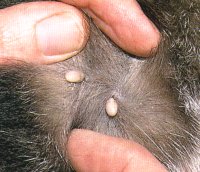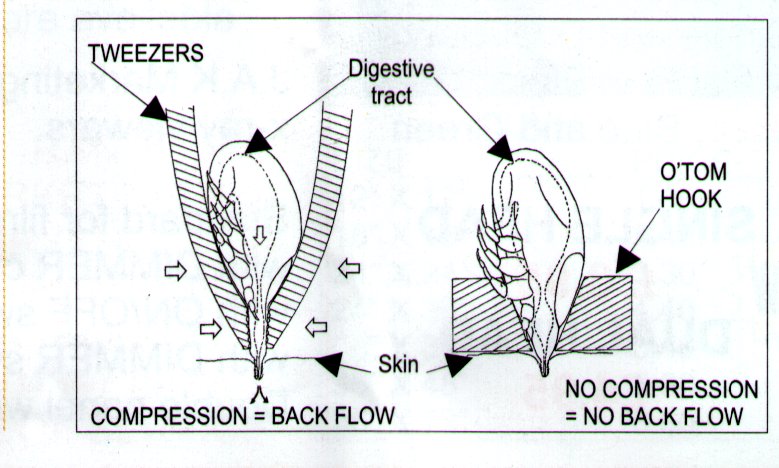
TICKS ON PETS First broadcast on www.provet.co.uk |
This information is provided by Provet for educational purposes only.
You should seek the advice of your veterinarian if your pet is ill as only he or she can correctly advise on the diagnosis and recommend the treatment that is most appropriate for your pet.
Ticks are disturbing for most owners because they are attached to your pet, and they are ugly with a glistening grey, brown, silver body. A tick can also transmit diseases.
Ticks are very common parasites which feed by embedding their biting mouthparts into the skin of their host. Once attached they should not be pulled off or killed (eg by burning with a cigarette) otherwise they will stay in situ and/or their mouthparts will not be released.

Two ticks attached to a cat. They have started feeding but are not yet engorged. (picture taken from A Colour Handbook of Skin Diseases of the Dog and Cat by Richard Harvey and Patrick McKeever used with the kind permission of Manson Publishing.
Ticks get onto your pet (and occasionally on to you !) from the environment, particularly when walking amongst long grass, or woodland areas. When they first come into contact with their "temporary restaurant" they are usually quite small - because they have finished digesting and using their last feed. Once attached to a new host they draw blood from the animal and their body swells up. You should remember that if your pet has one tick which you have found - there could well be others lurking elsewhere on the body - so further close examination is needed.
Are there any complications associated with tick infestations ?
Yes - there are several potential complications :
- A local nodule often appears at the site of attachment
- This can develop into an abscess
- In sensitive areas your pet may find the tick very irritating and scratch or bite at it causing self-trauma to the skin
- Lyme disease is transmitted to pets and humans by ticks - and this is an unpleasant disease with all sorts of signs which can be difficult to diagnose
- Tick paralysis is an uncommon problem following tick infestation and it is due to a neurotoxin transmitted by some tick bites. This causes lower motor neuron paralysis.
Having found a tick on your pet what should you do ?
Don't kill the tick by burning it - or even using potent insecticidal sprays. It is important to get the mouthparts out of the skin.
Also do not squeeze the body - this can cause backflow of blood and other tick gut contents into it's host.

This diagram reproduced with permission from Inform by JAK Marketing*
There are several approaches :
- Leave it alone. Most ticks will drop off when they have finished feeding.
- Use a specially designed tick remover - eg the O'Tom Hook Tick Remover - illustrated - recommended*.

- Other methods which are claimed to work include - spray or coat with surgical spirit or coat the tick with vegetable oil.
- Various insecticidal preparations are available from your veterinarian which will kill ticks (as well as other parasites such as fleas)
- Because of the potential transmission of Lyme Disease or other infections your veterinarian might advise a course of antibiotics.
(*JAK Marketing are based in the UK and can be contacted by fax on +44 1347 878308)
Updated October 2013